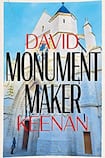
Scottish author David Keenan spoke to US composer William Basinski at The Social Gathering last March, a showcase of literature, music and art that was one of the most pleasantly diverting online events during lockdown.
Over the course of a hilarious chat about jewellery, collecting shoes and a tour of Basinski’s Los Angeles home, there was a palpable sense of two artists sharing a common attitude towards grief and humanity. In completely different ways, Basinski and Keenan commemorate lost souls by creating permanence in music and literature, one of the highest achievements of art.
Since the publication of This Is Memorial Device in 2017, a fictional oral history of the post-punk scene in his native Airdrie, Keenan has become one of the most prolific and innovative literary stylists of the past five years, garnering favourable comparisons to David Foster Wallace and Alan Warner. Now he publishes an epochal epic that asks whether books are capable of dreaming, echoing Roberto Bolaño’s 2666 in terms of sheer ambition and scale.
At this stage, Keenan can make his books do pretty much anything. Whatever about his books being able to dream, his characters have infiltrated mine, such as Miracle Baby, a strange oracle from his 2018 novel For the Good Times, about brutal IRA killers who adore Perry Como. His third novel, Xstabeth, published only last November, extrapolated on the development of a musical cult after the release of live recordings by an obscure folk musician, which Keenan brought to life as a mercurial, enigmatic and impenetrably mysterious figure in a book that reads like a feverish dream.
Four in one
Monument Maker is another highly progressive addition to an already astonishing oeuvre, a 808-page monster that staggers between France and the moon, the battle of Khartoum in1884 and the second World War, audaciously galloping through different eras and locations over the course of four books, Nave, Transept, Apse and Choir, and four appendices.
It is narrated by an injured soldier, liberates a love affair as an eternal summer, and addresses the small matter of bringing the dead to life. For the visionary Keenan, this level of achievement isn’t particularly surprising any more.
Monument Maker, which was originally titled The Tomb of Song, was reportedly begun in 2008. Keenan initially put it to one side after feeling he was falling into an abyss. He embarked on an unconscious mission to find his great-aunt’s husband, William Ferguson, who disappeared during the second World War. His great-aunt clung to the belief that William was still somewhere in Europe, having lost his memory, and couldn’t come home. When the Keenans went on holiday to Crete, they searched for a memorial to him. In the absence of finding any monument, Keenan maintains that his great-aunt began to believe that William was still alive.
Book two stylistically follows the format of a diary-style historical epic about Khartoum. Later, Keenan departs planet Earth. “I travelled to the moon, illegally, to join a protest against the building of a second spaceport in the Sea of Tranquility,” he writes. “There was the promise of riots of some good bands on the bill, which is what every adolescent dreams of.”
Monument Maker is also a riveting meditation on music, religion and art. Rembrandt is called the creator of the loneliest paintings in the history of art because they are suffused by the shadow of death but none of its lighting. Francisco Goya’s The Third of May 1808 in Madrid is astutely said to be lit by an impossible moon. It presents a highly accessible challenge for the reader in rewarding rerereading of separate sections and individual books. Keenan revels in producing highly innovative literary fiction that is also wonderfully entertaining.
In 2666, Bolaño wrote that reading is as natural as thinking, praying, talking, walking, or listening to music. Stephen King contended that 2666 is a novel that cannot really be described but is best “experienced in all its crazed glory”. This also applies to Monument Maker, Keenan’s most ambitious and accomplished book yet. He has has built a monument, turning history to dust in the process, and delivering a hefty instalment of a literary career where literally anything is possible.










